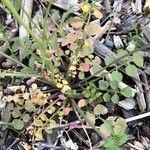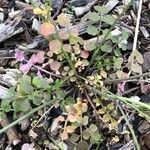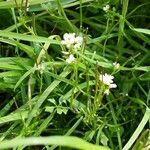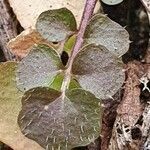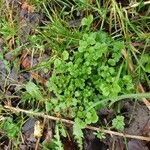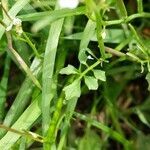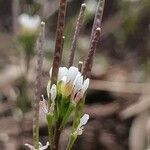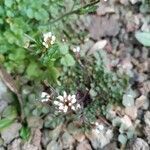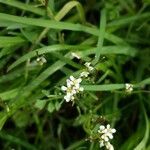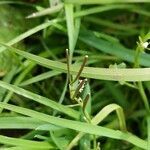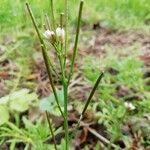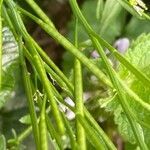Usually annual, branching from the base but not or very sparsely above (occasionally perennial and then branched above and devoid of leaf-rosette). Stems erect or in tall specimens curving, 5-30 cm high, glabrous or with scattered hairs. Basal leaves forming a distinct rosette, cauline leaves rather few; all leaves imparipinnate, with a terminal and 2-6 pairs of lateral leaflets, 1.5-10 cm long (including petiole); petiole non-auriculate, with a few straight hairs at base; leaflets rhombic, ovate, orbicular or reniform, truncate to broadly cuneate (in upper parts also narrowly cuneate), entire to deeply crenate, occasionally with secondary lobes, glabrous or with scattered hairs; terminal leaflet 0.5-1.5 by 0.3-2 cm, distinctly petioled, the lateral ones oblique, 0.2-1 by 0.2-1.1 cm, nearly sessile or with a petiole up to the length of the leaflet. Racemes terminal, very dense, with several small whitish flowers, in fruit rather lax (up to c. 10 cm long); pedicels in fruit erect to suberect (angle to stem usually c. 45° or less), 3-8 mm long with erect siliquae overtopping the flowers. Sepals green with narrow white margins, oblong, obtuse, c. 1.5 mm long. Petals white, narrowly spathulate, usually 2-3 mm long (rarely absent). Stamens 4-6; anthers c. 0.4 mm long. Ovary cylindrical with a very short style narrower than the ovary, and a flat stigma. Siliqua glabrous, linear, 12-27 by c. 1 mm; style 0.5-1 by c. 0.4 mm. Seeds reddish brown with a vestigial wing, broadly oblong to suborbicular in outline, c. 1 by 0.8 mm, smooth.
Annuals; sparsely hirsute basally (at least on petiole of basal leaves), often glabrous distally. Rhizomes absent. Stems erect, ascending, or decumbent, unbranched or branched basally and/or distally, (0.3-)1-3.5 (-4.5) dm, (not flexuous). Basal leaves (persistent to anthesis), rosulate, (5-)8-15(-22)-foliolate, (2-)3.5-15(-17) cm, leaflets petiolulate; petiole 0.5-5 cm, (ciliate); lateral leaflet blade oblong, ovate, obovate, or orbicular, smaller than terminal, margins entire, repand, crenate, or 3-lobed; terminal leaflet (petiolule 0.2-1 cm), blade reniform or orbicular, 0.4-2 cm × 6-30 mm, margins entire, repand, dentate, or 3 or 5-lobed. Cauline leaves 1-4(-6), compound as basal, petiolate, [(0.5-)1.2-5.5 (-7) cm, including petiole], leaflets petiolulate; blade base not auriculate; leaflets similar to basal. Racemes ebracteate. Fruiting pedicels erect to ascending, (2-) 3-10(-14) mm. Flowers: sepals oblong, 1.5-2.5 × 0.3-0.7 mm, lateral pair not saccate; petals (sometimes absent) white, spatulate, 2.5-4.5(-5) × 0.5-1.1 mm; (stamens usually 4, lateral pair often absent, rarely 5 or 6); filaments 1.8-3 mm; anthers ovate, 0.3-0.5 mm. Fruits linear, (torulose), (0.9-)1.5-2.5(-2.8) cm × (0.8-)1-1.4 mm, (often appressed to rachis); ovules 14-40 per ovary; style 0.1-0.6(-1) mm. Seeds light brown, oblong or subquadrate, 0.9-1.3(-1.5) × 0.6-0.9 (-1.1) mm, (narrowly margined). 2n = 16.
Herbs annual, (3-)10-35(-45) cm tall, sparsely hirsute at least along petioles of basal leaves, often glabrous above. Stems erect, ascending, or decumbent, 1 to several from base, simple or branched above, not flexuous. Basal leaves rosulate; petiole ciliate, 0.5-5 cm; leaf blade (1.5-)2.5-10(-13) cm, lyrate-pinnatisect; terminal lobe reniform or orbicular, 0.4-2 × 0.6-3 cm, margin entire, repand, dentate, or 3-5-lobed; lateral lobes (1-)3-7(-11) on each side of midvein, petiolulate, oblong, ovate, obovate, or orbicular, smaller than terminal lobe, entire, repand, crenate, or 3-lobed. Cauline leaves 1-4(-6), rarely absent, shortly petiolate, including petiole (0.5-)1.2-5.5(-7) cm; petiole base not auriculate; lateral lobes (2-)4-7(-10) on each side of midvein, ovate, oblong, oblanceolate, or linear, sessile or shortly petiolulate, entire, repand, or dentate. Fruiting pedicels erect or ascending, (2-)3-10(-14) mm, slender. Sepals oblong, 1.5-2.5 × 0.3-0.7 mm. Petals white, spatulate, 2.5-4.5(-5) × 0.5-1.1 mm, sometimes absent. Stamens 4 and lateral pair often absent, rarely 5 or 6; filaments 1.8-3 mm; anthers ovate, 0.3-0.5 mm. Ovules 14-40 per ovary. Fruit linear, (0.9-)1.5-2.5(-2.8) cm × (0.8-)1-1.4 mm; valves glabrous, torulose; style 0.1-0.6(-1) mm. Seeds light brown, oblong or subquadrate, 0.9-1.3(-1.5) × 0.6-0.9(-1.1) mm, narrowly margined. Fl. Feb-May, fr. Apr-Jul. 2n = 16.
Annual herb. Rhizomes 0. Stems often many from base of plant, suberect, glabrous, straight, green or purplish, 10-25-(40) cm tall. Lvs thin, green, sparsely hairy above and sometimes on petiole. Rosette lvs pinnate, petiolate; terminal leaflet circular, bluntly lobed, truncate to cordate, slightly > laterals; lateral leaflets in (1)-2-3-(4) pairs, ovate, bluntly lobed to entire, truncate to cordate and ± unequal at base; petiolules < leaflets. Cauline lvs pinnate, petiolate; terminal leaflet = to slightly > laterals, obovate to narrow-oblanceolate, cuneate, entire to bluntly lobed; lateral leaflets in 2-3 pairs, obovate, becoming narrow-oblanceolate, truncate becoming cuneate at base, bluntly lobed to entire; petiolules short. Infl. racemose, straight, glabrous, (5)-10-15 cm long. Pedicels glabrous, erecto-patent, (4)-6-10-(13) mm long at fruiting. Sepals sparsely hairy, purplish, pinkish or green, 1-2 × 0.4-0.6 mm; margins scarious. Petals white, erect, spathulate, 2-3 × 0.5-0.8 mm. Stamens 4-(6). Silique pale yellowish green, rarely with purplish valves, erect, (10)-15-20-(25) × 1-1.3 mm; valves glabrous or hairy; style c. 0.5 mm long. Seeds reddish brown, broad-oblong, very narrowly winged, c. 1 mm long.
Annual herbs up to 30 cm tall but frequently much smaller. Stems glabrous. Basal leaves crowded in a rosette, petiolate, 4-8 cm long, pinnate, 3-11-lobed, the lateral lobes obovate to circular, the terminal leaflet circular-reniform; leaflets angular-lobate, hairy on the upper surface; petiole flattened, ciliate. Stem leaves few, similar to the basal leaves but smaller and with narrower leaflets. Inflorescence a terminal raceme, few-to many-flowered, mostly dense in fruit. Flowers small with 2-3 mm long white petals. Stamens 4. Siliquae 1.5-2 cm long, c. 1 mm broad, erect, overtopping the flowers; valves smooth; style short, conical. Seeds c. 1 x 0.7 mm, very narrowly winged.
Annual with glabrous stems 1–4 dm; basal lvs numerous and conspicuous in comparison with the few small stem-lvs, the pl appearing subscapose; terminal lfl of basal lvs rotund to reniform, entire to shallowly few-lobed; petioles of the cauline lvs ciliate at least at base; lateral segments of the cauline lvs gradually narrower toward the top of the stem, obovate-oblong to linear-spatulate, often with 1 or 2 teeth, commonly hirsutulous above; pet white, 2–3 mm; pedicels narrowly ascending; frs erect, 1.5–2.5 cm; 2n=16. Widely distributed in the Old World; naturalized in moist, especially sandy soil from s. N.Y. to Ill. and Ala. Mar., Apr.
Annual slender herb to 30 cm tall, branching, erect, tap-rooted, sparsely hirsute. Basal leaves rosulate, petiolate, pinnate; pinnae 3–7 pairs, obovate or orbicular, the terminal pinna reniform; cauline leaves few and reducing; all leaves with pinnae lobed or angled and margins sparsely ciliate. Sepals c. 1.5 mm long, green-violet with narrow white margins. Petals 2.5–3 mm long, white. Stamens 4, rarely 6. Style c. 0.5 mm long. Siliqua linear, 15–25 mm long, 0.7–1.5 mm wide, erect, overtopping inflorescence; pedicels slender, curved, spreading, 5–10 mm long. Seeds ovoid, 1 mm long, compressed, narrowly winged.
A cabbage family herb. It is an annual or perennial plant. It forms a rosette or ring of leaves. It grows to a height of 50 cm and spreads to 30 cm. The stem is erect and the leaves are green and sword shaped. They usually have 3-7 pairs of leaflets. The flowers are pale mauve and small. They have 4 petals. They occur in clusters at the ends of branches. The fruit are 15-25 mm long pods, which are narrow and erect. They are about 1 mm thick. The seed are brown and with a smooth coat. They are about 1 mm long.
Annual herb, up to 300 mm tall. Basal leaves in a distinct rosette, pinnate; leaflets hairy on upper surface. Siliquas overtopping flowers. Flowers white.
Small annual, often much-branched or tufted at the base
Petals white.
